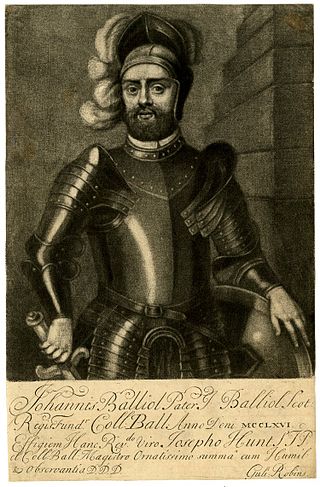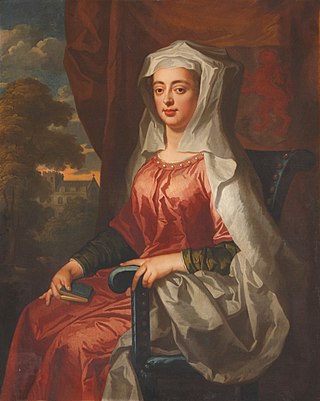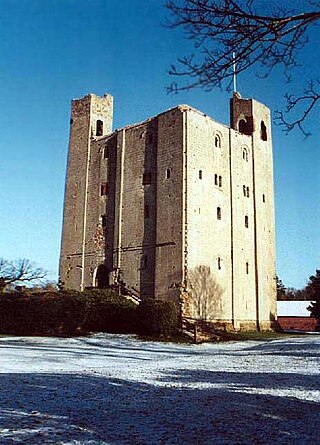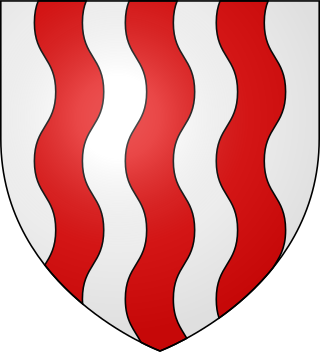Henry de Baliol | |
|---|---|
 Coat of arms as Lord of Cavers Argent, an orle gules | |
| Chamberlain of Scotland | |
| In office 1216–???? | |
| Personal details | |
| Died | 1246 |
Sir Henry de Baliol (died 1246) of Cavers was Chamberlain of Scotland.
Henry de Baliol | |
|---|---|
 Coat of arms as Lord of Cavers Argent, an orle gules | |
| Chamberlain of Scotland | |
| In office 1216–???? | |
| Personal details | |
| Died | 1246 |
Sir Henry de Baliol (died 1246) of Cavers was Chamberlain of Scotland.
Henry was a younger son of Eustace de Balliol and Petronilla FitzPiers. Although invited by King John of England to take his side shortly before the time of Magna Carta, it is probable that he, like his sovereign Alexander II, joined the party of the barons. He is mentioned in the Scottish records in the years between 1223 and 1244, and the appointment of Sir John Maxwell of Caerlaverock, who appears as Lord Chamberlain of Scotland in 1231, must either have been temporary, or Baliol must have retained the title after demitting the office, which George Crawfurd supposes him to have done in 1231. In 1234 he succeeded, in right of his wife as co-heiress, along with her sisters; Christina and brother-in-law Peter de Maule and Isabel, who married David Comyn, to the English fiefs of the Valognes family, vacant by the death of Christian, countess of Essex; it was a rich inheritance, situated in six shires.
In 1241 he attended Henry III of England to the Saintonge War. Dying in 1246, he was buried at Melrose Abbey.
Henry married Lora de Valognes, daughter of William de Valognes, lord of Panmure and had the following known issue;

John Balliol or John de Balliol, known derisively as Toom Tabard, was King of Scots from 1292 to 1296. Little is known of his early life. After the death of Margaret, Maid of Norway, Scotland entered an interregnum during which several competitors for the Crown of Scotland put forward claims. Balliol was chosen from among them as the new King of Scotland by a group of selected noblemen headed by King Edward I of England.

Saer de Quincy, 1st Earl of Winchester was one of the leaders of the baronial rebellion against John, King of England, and a major figure in both the kingdoms of Scotland and England in the decades around the turn of the twelfth and thirteenth centuries.

Roger de Quincy, 2nd Earl of Winchester, and the hereditary Constable of Scotland, was a nobleman of Anglo-Norman and Scottish descent who was prominent in both England and Scotland, at his death having one of the largest baronial landholdings in the two kingdoms.

The House of Balliol was a noble family originating from the village of Bailleul in Picardy. They held estates in England, granted during the reign of King William Rufus. Through marriage, they had claims to the Throne of Scotland. One member of the family, John Balliol, was named King of Scotland after the disputed succession following extinction of the Dunkeld line. John was deposed, leading to the First War of Scottish Independence. His son, Edward Balliol, also briefly controlled the Scottish throne during the Second War of Scottish Independence. Edward had no issue, and the direct line went extinct with him.

John de Balliol was an English nobleman, belonging to the House of Balliol. Balliol College, in Oxford, is named after him.

Robert V de Brus, 5th Lord of Annandale, was a feudal lord, justice and constable of Scotland and England, a regent of Scotland, and a competitor for the Scottish throne in 1290/92 in the Great Cause. He is commonly known as "Robert the Competitor". His grandson Robert the Bruce eventually became King of Scots.

Dervorguilla of Galloway was a "lady of substance" in 13th century Scotland, the wife from 1223 of John de Balliol and mother of John I, a future king of Scotland.
John Comyn (Cumyn) was Lord of Badenoch in Scotland. He was Justiciar of Galloway in 1258. He held lands in Nithsdale and Tynedale.
Sir Archibald Douglas was a Scottish nobleman, Guardian of Scotland, and military leader. He is sometimes given the epithet "Tyneman", but this may be a reference to his great-nephew Archibald Douglas, 4th Earl of Douglas. He fought and died at the Battle of Halidon Hill.
Holders of the office of Lord Chamberlain of Scotland are known from about 1124. It was ranked by King Malcolm as the third great Officer of State, called Camerarius Domini Regis, and had a salary of £200 per annum allotted to him. He anciently collected the revenues of the Crown, at least before Scotland had a Treasurer, of which office there is no vestige until the restoration of King James I when he disbursed the money necessary for the maintenance of the King's Household.

Sir Ingram de Umfraville was a Scottish noble who played a particularly chequered role in the Wars of Scottish Independence, changing sides between England and Scotland multiple times, throughout the conflict.

Hugh de Vere, 4th Earl of Oxford was the only son and heir of Robert de Vere, 3rd Earl of Oxford and Isabel de Bolebec, daughter and eventually sole heiress of Hugh de Bolebec.

Scot's Hall was a country house in Smeeth, between Ashford and Folkestone in southeast England. It was the property of a gentry family, the Scotts. The first known resident was Sir John Scott, who married Caroline Carter.
Philip de Valognes, Lord of Ringwood, Benvie and Panmure was an Anglo-Norman Scottish noble. He was the Lord Chamberlain of Scotland between 1165–1171 and 1193–1214.

William de Valognes also known as William de Valoynes, was the only son of Philip de Valognes and was granted a charter of the baronies of Panmure and Benvie by King William the Lion, previously granted to his father. On his father's death in 1215, William de Valongnes was made High Chamberlain to Alexander II. He died in 1219 and was interred at Melrose Abbey.

Alexander de Baliol, Baron Balliol, Lord of Cavers was an Anglo-Scottish noble. He served at one time as Chamberlain of Scotland.

de Valognes is a family name of two distinct powerful families with notable descendants in the centuries immediately following the Norman Conquest. Although a connection between them has been inferred by some authorities, this is not supported by positive evidence.
John Lindsay, Lord of Wauchope and Staplegorton, was a Scottish noble.
Gilbert de Gaunt, 1st Baron Gaunt, Lord of Folkingham was an English noble.

Guy de Balliol of Cavers in Scotland, Benington and Higham Balliol in England, was an Anglo-Scottish noble. He was the standard bearer of Simon de Montfort, Earl of Leicester at the Battle of Evesham and was killed during the battle.
![]() This article incorporates text from a publication now in the public domain : "Baliol, Henry de". Dictionary of National Biography . London: Smith, Elder & Co. 1885–1900.
This article incorporates text from a publication now in the public domain : "Baliol, Henry de". Dictionary of National Biography . London: Smith, Elder & Co. 1885–1900.